In the modern enterprise company, things move faster than ever before, making employee productivity crucial to its success. If you think your old systems and interfaces are working just fine, take a second look and you’ll likely find outdated practices and slow processes that can be eliminated.
Better productivity can result in higher profit by reducing the enterprise’s operational costs. With more discipline about productivity, employees can often achieve more in less time. This improves the overall employee engagement and reduces burnout. Organizations have happier customers that are more likely to champion their products or services.
Being productive sometimes means becoming more focused and less distracted. It also means not wasting time on rote tasks. The good news is that there are several software tools in the market that can help increase productivity.
This blog looks at top 6 productivity tools that we commonly hear about from enterprise-size companies. The software tools on this list are among our favorites for helping enterprises be more productive. This is by no means a comprehensive list, but we hope it provides you with some useful suggestions.
Top 6 enterprise productivity tools
Zoom

Zoom makes video and web conferencing frictionless. Zoom is the leader in modern enterprise video communications, with a secure, easy platform for video and audio conferencing, messaging, and webinars across mobile, desktop, and room systems.
Microsoft Teams, Cisco WebEx Teams, Google Meet and Zoom are all top contenders in this thriving market. Each platform has its own combinations of features, strengths and weaknesses.
However, Zoom’s extremely intuitive features and interface have made it one of the most popular choices among organizations and users alike. Unlike some of its competitors, Zoom doesn’t require new or occasional users to download extensions or wait to join meetings.
Also, Zoom’s one-touch feature is consistent across all endpoints, allowing users to join or start a video conference or meeting across several devices.
Enterprises also tend to prefer Zoom because while Zoom can be activated instantly on its own cloud, organizations can also deploy Zoom as a hybrid service with meetings hosted in their private cloud by using Zoom Meeting Connector. With the ability to scale capacity quickly and easily, and failover and load-balancing features built in, Zoom ensures reliability and consistency.
One of Zoom’s biggest benefits is its accessibility. Setting up a Zoom Meeting is as easy as clicking an invitation link to launch the app or prompt users to install the interface, which works well on both desktop and mobile devices.
Zoom is continually updating and improving its technology, offering things like virtual backgrounds, which superimpose over your existing meeting room (which if working from home may be your messy living room).
It also has some features that are more whimsical than necessary, like a ‘Touch Up My Features’ facility which enables users to soften their appearance on camera.
Zoom offers some great integrations too — including some Google apps and services. For example, Zoom integrates with Facebook Workplace, Skype for Business, Salesforce, Microsoft Outlook, Google Drive, Google Calendar, and more.
Price
Zoom does have a number of paid plans which may be more suitable for your needs. It has a free plan to get you started and goes up to $19.99 /month/license for the enterprise account. More details about the different plan can be found on Zoom’s Pricing Page.
Microsoft Office 365 suites
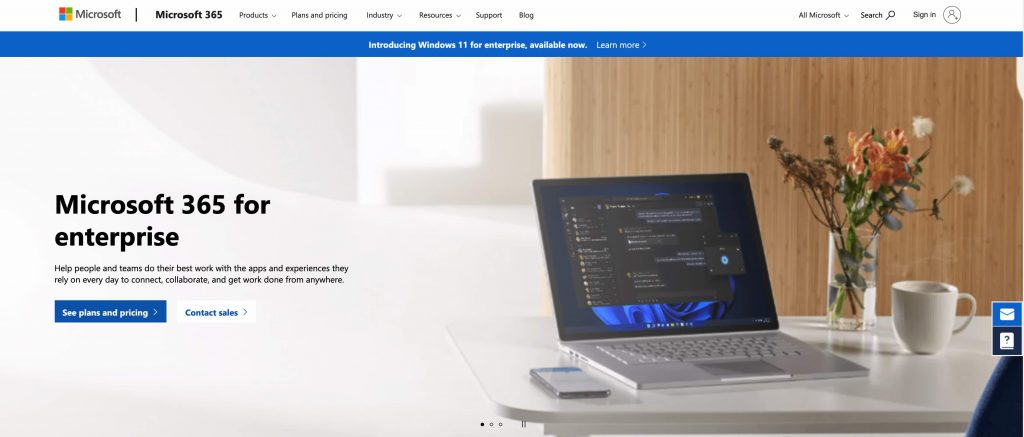
Microsoft Office 365 (formerly Office 365) is a de facto part of the enterprise software stack because it’s used so frequently in daily business operations, for tasks like drafting documents, writing reports, creating budgets, or building presentations.
Office 365 has a proven commitment to confidentiality, integrity, and availability, ensuring business continuity in case of a data breach or physical disaster.
By contrast, other solutions such as Google Apps adheres to Google’s single privacy policy, which is shared across business and consumer applications. This means that Google’s data protections may not address certain industry regulations or security requirements. Besides Microsoft’s brand cognizance and loyal enterprise user base also make Office 365 a natural choice for enterprises.
With a Microsoft 365 subscription, enterprises get access to desktop and mobile apps like Microsoft Excel, Outlook, Word, PowerPoint, OneNote and SharePoint. Its cloud-based software includes collaboration tools for document editing and sharing. There are also tools for emailing, calendar coordination, and file storage.
Office can help teams organize a lot of work in one place – it’s easy to move seamlessly right from email to calendar to tasks and documents. It helps teams to automate business workflows and processes, and provides data security and privacy through user authentication and policies.
Collaboration and communication are the key components of productivity in the modern enterprise, and productivity is the lifeblood of the enterprise. Microsoft 365 provides the tools necessary to bring collaboration and communication–and by extension, productivity–to each individual in an enterprise.
Price
The Microsoft 365 Business Basic plan starts with USD$5.00 per user/month while the Microsoft 365 Apps plan is available for USD$20.00 per user/month. Microsoft also offers a free month trial. More details can be found on Microsoft 365’s pricing page.
Slack
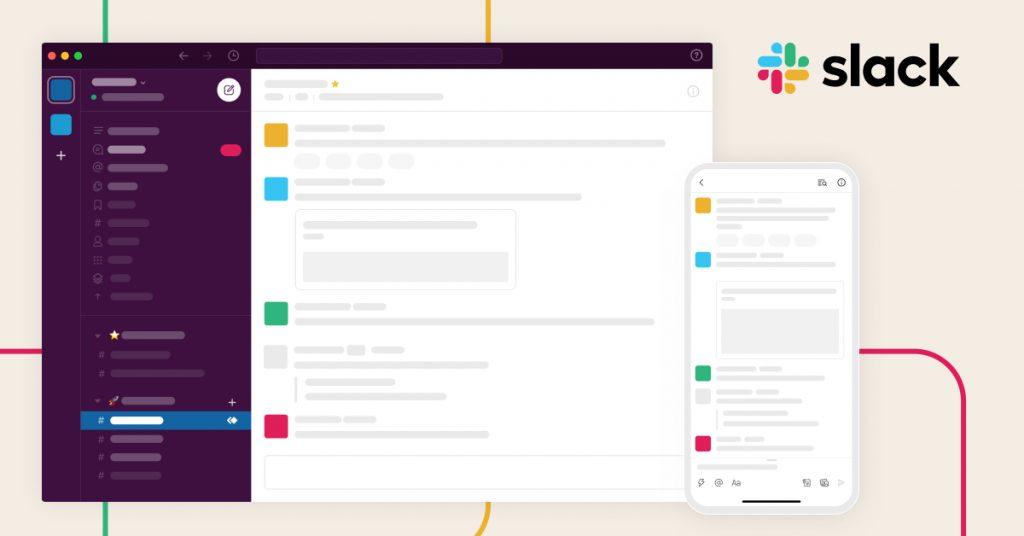
Team communication can make or break a team’s productivity. This is why Slack endeavors to make it simpler and more straightforward for everyone. Slack helps companies from small startups to larger enterprises organize their employees into groups all within one simple platform.
Within the Slack app, users can create one or multiple channels, each of which can either be set to public or private to a few select team members. This helps keep conversations on one topic in a single chat.
But the thing that really sets Slack apart from other messaging apps is its library of apps. Whatever functionality you can think of, there’s probably an app for it. From automatic meeting minutes and automatically saving attachments to Google Drive or Dropbox, to adding tasks to your to-do list manager. While some of these apps are paid, a large chunk of them are free making Slack a perfect, cost-effective option for small businesses.
Recently Slack announced the version of its popular work chat application that is designed for enterprises. The new Enterprise Grid product is aimed at helping companies administer and connect multiple chat instances.
Grid allows administrators to set up each team inside an organization with its own centrally managed Slack instance. Those workspaces can then be linked together using shared channels, and all of the people inside an enterprise can direct-message one another, even if they’re not part of the same workspace.
No wonder why 43% of Fortune 100 businesses pay to use Slack.
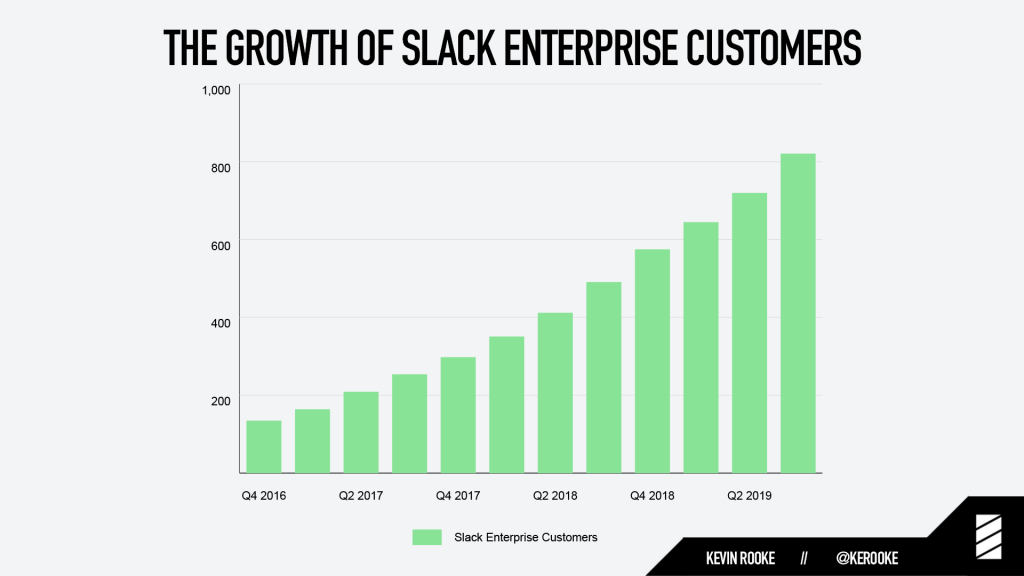
Price
Slack is free for enterprises to try, and it also supports an enterprise plan. Apart from this, Slack also has a few more plans, details of which are available on Slack’s pricing plan.
Jira
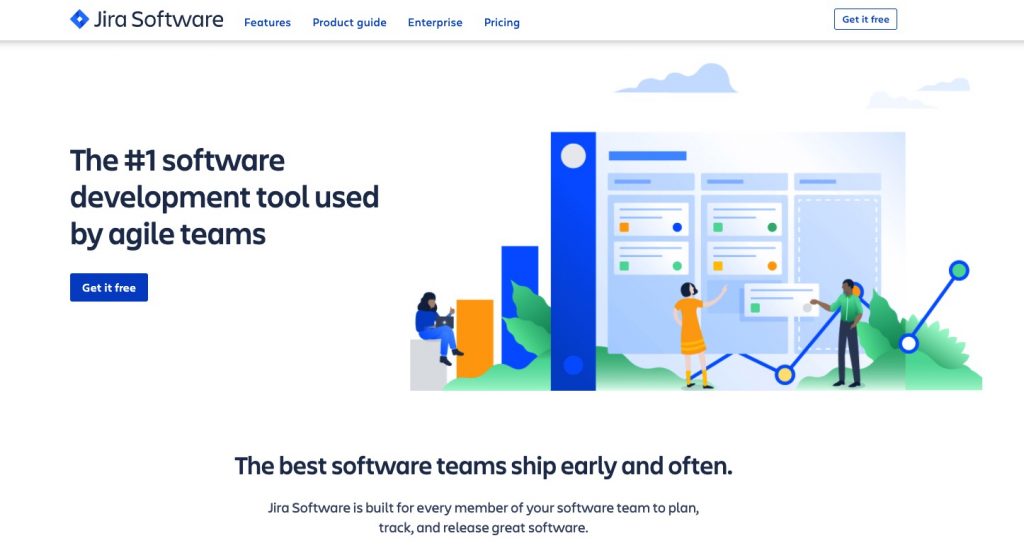
Jira is a project management software that enables enterprises to efficiently track large-scale projects, tasks, resources and finances. It helps clarify priorities, enable all team members to be accountable, and ideally facilitate seamless collaboration.
Jira also helps meet a variety of project management needs, from multi-project scheduling and task management to time tracking and advanced analytics. Strong reporting tools are also included, enabling better analytics and control.
Jira is also equipped with functions such as strong email integration and notifications, for fast and simple access and mobile apps to help users stay connected even when they’re not in the office.
The most used project management software features are task management, reporting, and collaboration, but the best project management software for an enterprise depends on the type of work they do. And the beauty of Jira is that it enables teams to easily customise the workflows, collaborate among teams, and ultimately deliver a great product.
Many enterprises prefer Jira over project management tools because JIRA is considered a more modern and actively supported tool. It supports concepts like agile, sprint planning, sprint estimations, sprint boards, dev teams, customized workflows, support team and external integrations etc.
It also works across many browsers with an updated UI, has an active community, and has cloud deployment options. Not forgetting the many external integrations with other enterprise tools like Jenkins, Slack, etc.
Jira’s top-tier plan expands on the advanced features of Cloud Premium for businesses with multiple product instances and advanced security needs. It also has advanced admin controls and reporting to manage users and product changes across all the cloud instances.
Jira leans more towards agile software development teams. However, if you are looking for an all-in-one productivity platform that also offers features like Jira, then you should consider Asana contrary to Jira.
Price
Jira has a free plan for upto 10 users and also offers an enterprise-level plan. More details are available on Jira’s pricing page.
nTask
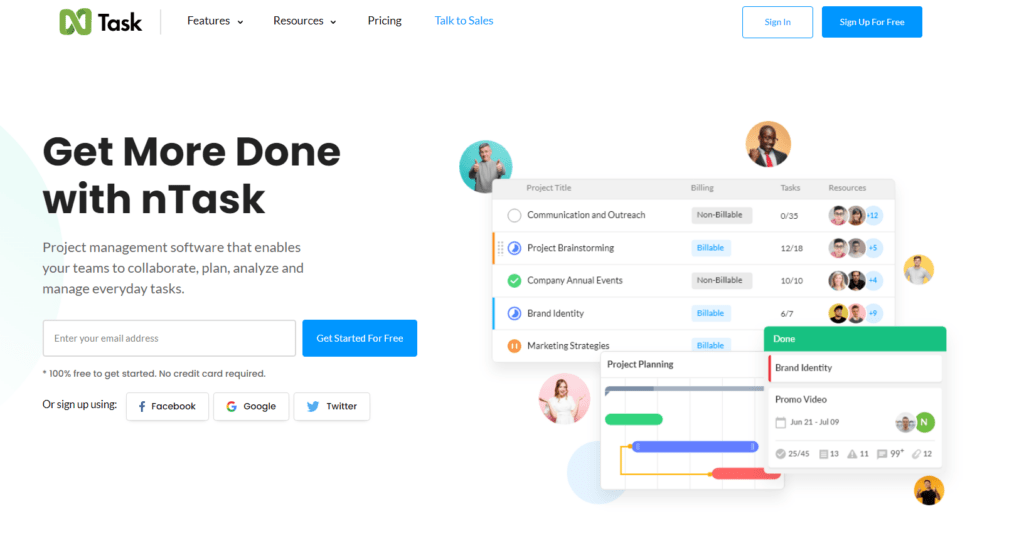
nTask is an all-in-one enterprise project management software smart teams use to manage work productively. It helps enterprise teams to plan, manage, execute, and evaluate even the complex projects with ease. It brings the whole organization to a single page, and makes them work in order to achieve the bigger company goals.
This platform consists of more than ten modules that makes the perfect recipe to run projects efficiently. It is designed to help teams of all sizes to collaborate on tasks, projects, and boards with separate workspaces. Organizations can create multiple teams to separate the work of each department, and bring cohesion in the workflows.
nTask help meet project goals by setting milestones for the work, assign tasks to the team members, set priority, create to-do lists, time tracking with full timesheet approval system, and robust task management to record the work efforts.
One of the favorite enterprise user’s features are interactive Gantt charts, and risk matrix. These can be used for analyzing the project workflows, while tracking the budget and financial summary of the project, and mitigating risk involved in operations. nTask supports the agile, work estimation, and lean methodology.
The Kanban board features help users to improve productivity of their task management efforts, and give several pre-built templates to get started for any use case. Users can easily import their work from other platforms into nTask, and export data in CSV format in just a few clicks.
nTask work on any browsers, and connects seamlessly with any devices. It is a cloud-based platform, and help users to stay connected on the go with the help of Android and iOS application. The enterprise customers can have upgraded benefits like white-labeling, custom servers, self-hosting, two factor authentication, better security and dedicated support. It gives options for users to fully customize their experience, and get custom onboarding in the Enterprise plan.
Price
nTask has a free basic plan to test out the platform with 5 users. The Premium plan is affordable for startups with $3/user, while Business plan with many upgraded features is at $8/user per month. User’s can contact for Enterprise custom plans for the maximum benefits from the system. More details are available on the nTask’s pricing page.
Time Doctor
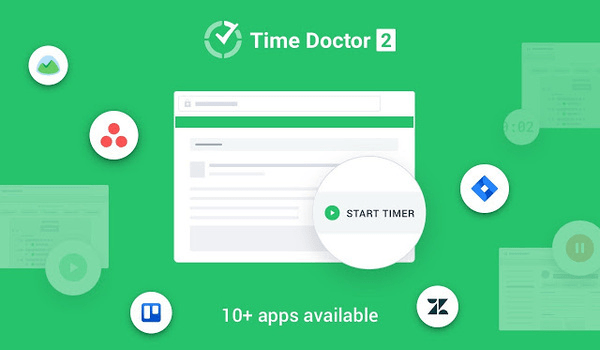
Time Doctor is a time tracking and productivity software that analyzes how enterprise teams use their time to provide clear direction on how to improve performance and productivity.
Time Doctor provides detailed analytics of where time is spent on the work day, empowering employees to increase productivity and results. Time Doctor gives quantifiable data that shows the time worked on different projects, accounts, tools and apps.
Its Workday Insights provide both leaders and employees with accurate, actionable data that creates a greater understanding of when and how teams are the most productive, making the dynamic between employees and their managers more constructive. Managers can see employee dashboards and how they are tracking against goals they’ve set. If employees get off track, it’s easier to see why and how and help them course correct.
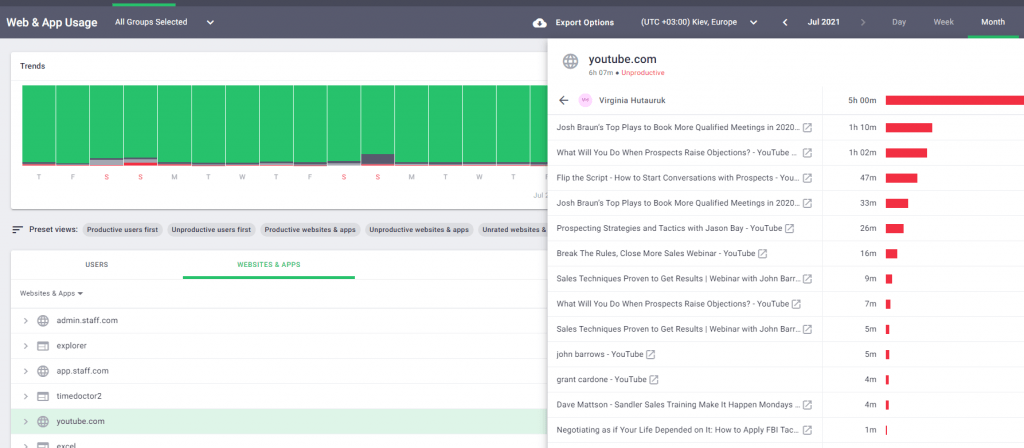
Through Time Doctor’s dashboards and reports, employees can analyze their daily work patterns and identify potential distractions as well as opportunities for more training. Time Doctor empowers employees to use the data to increase their own performance and work more autonomously.
Time and attendance management features from Time Doctor ensure that payroll reporting in enterprises is accurate. Time tracking is simplified with employee timesheets, and that data is sent directly to the payroll system.
Employees can quickly and easily log their hours with a click of the mouse, while HR staffers avoid wasting time manually entering data from paper timesheets. Managers are able to track the efficiency of their staff with these systems and identify coaching and development opportunities, as well as quickly see when employees are putting in overtime.
Time Doctor also provides a range of options available for user and team settings, company and account settings, that allow enterprises to customize the system according to their needs. Enterprises are able to turn on and off options as needed, including screenshots, and more.
Price
Time Doctor’s pricing starts from $7 per user per month and goes till $20 per user per month. It also offers a free 14 day trial on every plan. More details are available on Time Doctor’s pricing page.
Conclusion
Many of today’s most effective enterprise productivity tools can be accessed anywhere on any device, including mobile phones and tablets with proper security measures. They offer quick setup and easy-to-use graphical user interfaces. Mobile-based productivity apps and tools enable easier access to employees, data, and cloud storage, all of which contribute to better collaboration.
Enterprise productivity solutions such as the ones we have mentioned here are indeed helpful for ensuring that your teams are using their time effectively. However, enterprise productivity tools can’t do the job alone.
Ultimately, productivity improvement in an organization requires a cultural transformation. It boils down to people discarding their old ways of working and embracing newer and more productive ways.
To gain the most benefits, enterprises must identify and remove any roadblocks that may be preventing a collaborative environment and make sure that the tools they are using are those that will benefit employees as well as the organization.

Rajat is a marketing generalist at Time Doctor. He has over 10 years of marketing experience working on product marketing, growth hacking and digital marketing. He is an avid traveller and passionate about improving employee productivity.


